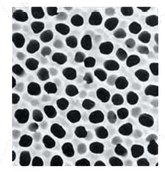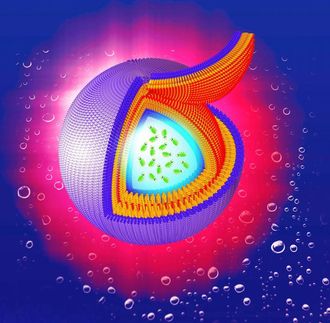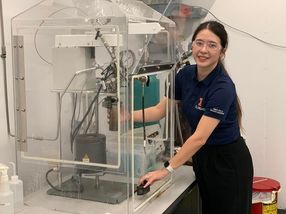Nanoscale Fiber Optics
Lipid membranes as molds for doped cadmium chloride nanowires with light-conducting properties
Advertisement
One-dimensional nanoscopic structures such as nanowires are important building blocks for future miniature opto-electronic components. Swiss researchers have now developed a new method for the production of nanowires; they use lipid membranes as "molds" and obtain high yields of cadmium chloride nanowires that behave as light conductors.
"Syntheses that use molecular molds have advantages", explains Horst Vogel, "they are simple, work under mild conditions, and deliver unique, precisely defined nanostructures". Vogel and his team selected phospholipid membranes as molds. Phospholipids consist of a water-friendly head group and water-repellent tail groups (hydrocarbon chains). In aqueous surroundings, they line up tail to tail into double-layered membranes. If these are dried carefully, stacks of membranes are formed, in which the head groups that point toward each other are separated by nanometer-wide water films. Some types of head groups are able to selectively bind certain positively charged ions. This is the basis of the Swiss researchers' technique. They took phospholipids with a preference for cadmium ions and produced membrane stacks with high cadmium concentrations. They then treated these with hydrochloric acid fumes. The hydrogen atoms from the hydrochloric acid forced the cadmium ions out of the binding sites and drove them into the water layer between the membrane layers. Here they combined with the negatively charged chloride ions from the acid to form tiny cadmium chloride crystals, which then continued to grow into one-dimensional wires. Why only one dimension? Beyond a certain crystal size, the lipid head groups, given a positive charge by the hydrogen atoms, begin to interact with the surfaces of the crystal which are rich in negatively charged chloride ions. The crystal thus cannot grow any further at those surfaces. Because of the special crystal structure, one of the crystal surfaces is protected from these interactions by water molecules, which are also a part of the crystal lattice. Here the crystal continues to grow. In this way, wires of up to 170 µm long and only about 100 nm in diameter are formed, which consist of a single continuous crystal.
If the hydrochloric acid vapor is augmented with hydrogen sulfide, the result is cadmium chloride nanowires that contain fluorescing cadmium sulfide nanocrystals. "If we irradiate one of these nanowires in the middle, we don't only observe fluorescence at that one location but also at both ends", says Vogel. "The nanowire conducts the light, just like an optical fiber."
Other news from the department science
These products might interest you

Anopore™ by Cytiva
Precise filtration made easy with Anopore inorganic membranes
The aluminum oxide filter membrane that can increase the purity or yield of your analyte

Hahnemühle LifeScience Catalogue Industry & Laboratory by Hahnemühle
Wide variety of Filter Papers for all Laboratory and Industrial Applications
Filtration Solutions in the Life Sciences, Chemical and Pharmaceutical Sectors

Get the chemical industry in your inbox
By submitting this form you agree that LUMITOS AG will send you the newsletter(s) selected above by email. Your data will not be passed on to third parties. Your data will be stored and processed in accordance with our data protection regulations. LUMITOS may contact you by email for the purpose of advertising or market and opinion surveys. You can revoke your consent at any time without giving reasons to LUMITOS AG, Ernst-Augustin-Str. 2, 12489 Berlin, Germany or by e-mail at revoke@lumitos.com with effect for the future. In addition, each email contains a link to unsubscribe from the corresponding newsletter.
































































